Lake Como Poetry Way
Lake Como Poetry Way
The Lake Como Poetry Way is a 16-km pedestrian itinerary across the towns of Maslianico, Cernobbio, Como and Brunate, which are on Lake Como. The peculiarity of the itinerary is that its narration is made through 16 historical figures that have lived and have depicted these places in their works. The itinerary is mapped also by 12 Little Free Libraries dedicated to the free exchange of books (in any language).
Understand
The itinerary connects places which are characteristic of this territory and creates around such places an original storytelling. The places are narrated through the eyes of historical figures that have woven ties with the territory and specifically with the monuments and locations touched by the itinerary.
Prepare
It is recommended to use trekking shoes, especially if you are willing to walk from stage no. 13 to stage no. 14, as the path here follows an old mule track between Eremo di San Donato and Brunate. If for this part of the itinerary you choose to take the funicular, then comfortable and adequate shoes for the 16-km length are sufficient. For the walk from stage no. 13 to stage no. 14, it is also recommended to bring a water bottle.
Starting altitude: 335 m a.s.l.
Arrival altitude: 715 m a.s.l.
Difference in level: 654 m (137 descending, 517 ascending)
Duration: 6 hours (without variations, and without stopping to visit all sites, more time needs to be taken into account in this case).
Type of activity: Hiking
Difficulty: Touristic
Get in
This itinerary starts from Roggiana Pass (on the border between the Italian community of Maslianico and the Suisse community of Vacallo) and ends in Brunate, crossing Cernobbio and Como, however it can be fractioned at will or followed in the opposite direction.
From Como, the starting point can be reached using public transport ASF urban line no. 6.
Stages
The itinerary is organised in 16 stages crossing through some of the most important sites in Roggiana, Cernobbio, Como and Brunate. Associated to each stage one or more anecdotes of an historical figure.
Roggiana
- Roggiana Pass, 45.84754°, 9.04428°. via Scaletto - (go to stage)
Cernobbio
- Villa Besana-Ciani, 45.84014°, 9.07690°. via Besana - (go to stage)
- Villa del Grumello, 45.82315°, 9.06741°. via per Cernobbio - (go to stage)
Como
- Villa Olmo, 45.81905°, 9.065386°. via Simone Cantoni - (go to stage)
- Villa Gallia, 45.81546°, 9.06704°. via Borgovico - (go to stage)
- War Memorial, 45.8149°, 9.07358°. viale Giancarlo Puecher - (go to stage)
- Tempio Voltiano, 45.814833°, 9.075264°. Lungo Lario Marconi - (go to stage)
- Piazza Cavour, 45.81300°, 9.08097°. - (go to stage)
- Duomo of Como (portal), 45.81157°, 9.08324°. piazza del Duomo - (go to stage)
- Duomo of Como (south facade), 45.81153°, 9.08370°. via Mestri Comacini - (go to stage)
- Town Theatre, 45.81152°, 9.08491°. piazza Verdi - (go to stage)
- Piazzetta Baratelli, 45.82471°, 9.07912°. - (go to stage)
- Museo Civico, 45.808702°, 9.086206°. piazza Medaglie d'Oro - (go to stage)
Brunate
- Mule Road Como - Brunate, 45.81120°, 9.09545°. con partenza dalle scalette a Como - (go to stage)
- Public Gardens Alessandro Volta, 45.81944°, 9.09592°. via Funicolare - (go to stage)
- Faro Voltiano, 45.82610°, 9.10046°. via Giacomo Scalini - (go to stage) <br>
The itinerary is also mapped by 12 Little Free Libraries listed below, where you can take and leave books free of charge.
Little Free Libraries
| | | | > Maslianico, Valico di Roggiana 📍, via Scaletto > Cernobbio 📍, via Carcano angolo via Mondelli > Cernobbio, Giardino della Valle 📍, via Adda > Cernobbio, Riva 📍, piazza Risorgimento > Cernobbio, Villa Bernasconi c/o Bar Anagramma 📍, via Regina 7 > Como, Serretta del Grumello 📍, via per Cernobbio 11 | | > Como, Giardino delle Rose 📍, via Sant'Elia 6 > Como, Giardino Maggiolini 📍, piazza Verdi > Como, Punta 📍, piazzetta Baratelli > Como, Mulattiera per Brunate 📍, salita San Donato 6 > Brunate, Biblioteca 📍, via Funicolare 16 > Brunate, loc. San Maurizio 📍, Via Scalini 66 |
The itinerary
1 - Roggiana Pass, Luigi Dottesio
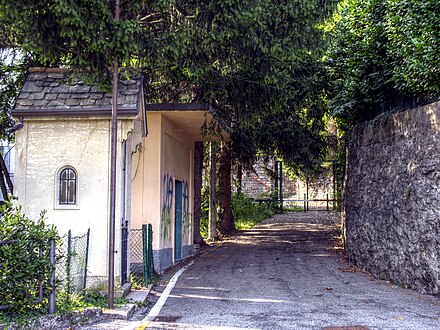
The itinerary starts from the border between Italy and Switzerland, between the towns of Vacallo and Maslianico, a frontier by the name of Roggiana Pass (in Italian Valico di Roggiana), one of the very well known smuggling routes between the two countries.
«Our forefathers erected a statue for him in a sacred place: it would be worthy of the kindness of our present times to grant prestige to our Country with a work of art connecting the ages of our two great fellow citizens, Pliny and Volta».
This is what Luigi Dottesio wrote about Pliny the Elder in his book Biographical Notes on Illustrious Comaschi, published in 1847 in Switzerland by the Tipografia Elvetica of Capolago. The author, back then deputy secretary of the municipality of Como, smuggled prohibited books published by this tipography in the Lombardo-Venetian Kingdom. A contraband of culture and ideals which Dottesio paid with his life. He was here, at Roggiana Pass the starting point of this itinerary, arrested on 12 January 1851. He was then hanged in Venice on 11 October 1851. As martyr to press freedom, he leaves in inheritance a biography still today of inspiration. Dottesio was also the first ordinary man to represent Como and its province in official occasions. His sacrifice was for a country which he hoped to be united by its culture.
From the Swiss border, one heads towards Lake Como.
Distance between the first and second stage: 3 km, on foot approx. 30 min slightly downhill.
Note: this distance can be travelled by car, by following an alternative route which avoids pedestrian-only paths, and leaving the car at the Villa Erba Parking in Cernobbio along SP71 - Vecchia Regina.
2 - Riva di Cernobbio, Vincenzo Monti

From Roggiana Pass head on along via Scaletto, which then becomes via per la Svizzera and then via Vittorio Emanuele II, up to the crossroad with via Battista Mondelli. Here turn right, and then continue along via Battista Mondelli__until reaching the junction with_via Paolo Carcano. Here turn right again on_via Paolo Carcano_and after a few meters take_via Don Giovanni Minzoni_(pedestrian only road) on the left. At the intersection with_via XXV Aprile_turn left and after few meters right, taking another pedestrian only road that leads to_via Giandrini_. Continue walking along_via Giandrini_until reaching a roundabout. Here take the second road on the left (SP71 - Vecchia Regina) for a few meters and then turn right on_via Monti_, that then becomes_via Besana_, where the second stage of this itinerary is located:_Villa Besana-Ciani'.
The villa, confined between via Besana' and the Riva di Cernobbio (lakeshore promenade), was built in the 17th century as a country house for the Londonio family and saw as guest the poet Vincenzo Monti (1754-1828), one of the most prominent actors of Italian Neoclassicism.
In this scenic landscape, which between the 18th and 19th centuries appeared much more wild and verdant than today, Vincenzo Monti sets about thirty lines of the poem Feroniade dedicated to the daughters of his host, Carlo Giuseppe Londonio, a man of letters and a politician. Monti began working at Feroniade in 1784 but the poem was published posthumous in 1832. In these thirty lines, the poet imagines Londonio's daughters busy gathering violets:
:«Ambassador of April, hail to : thee when through the hedgerows : Of pleasant Cernobbio in the morning : Isabella and Emilia, soulful maidens, : Prey on you and celebrate you, and you, o blessed, : Walk through the snow of their virginal bosoms : Acquiring new fragrances, Go on! move, : O kind violet, these words: : In springtime the first flowers greet : The roses from Cernobbio».
In 1869 the villa was purchased by the brothers Carlo ed Enrico Besana, hence its current name, who turned it into a place of gathering for Lombard patriots. The villa is still today owned by the Besana family and through the years has maintained its original structure and characteristics. The garden with its grand plane and beech trees still preserves its original charm.
Before moving on to reach the third stage, one can decide to take a detour to visit the characteristic sites of Cernobbio: the lakeshore promenade and the Giardino della Valle. Further details available in the section dedicated to deviations.
Distance between the second and third stage: little more than 2 km, on foot approx. 25 min of flat standard road.
Note: this distance can be travelled by car, following the road along the lake toward south (towards Como) from the parking Villa Erba along SP71 - Vecchia Regina, to the parking Villa Olmo at Lido di Villa Olmo (this parking can be very busy at summer time).
3 - Villa del Grumello, Ugo Foscolo

Leaving behind Villa Besana-Ciani, take the road followed on the outwards up to the turn between via Besana and via Monti. Here take the pedestrian road on the left that leads to via Luigi Erba and then follow via Luigi Erba, in the direction opposite to the one leading to the lake, up to the roundabout on SP71 - Vecchia Regina. Here take the first road on the right and continue straight on skirting along the lake shore on SP71 which then becomes via per Cernobbio. At the height of Villa Sucota, official seat of the Antonio Ratti Foundation and the Textile Museum, leave the main road an follow the trail Chilometro della Conoscenza (marked as KM_C and meaning The Knowledge Kilometer) along the path which coasts the lake, thereby reaching the third stage.
Marking the arrival is the bust of Ugo Foscolo (1778-1827), positioned in the gardens of Villa del Grumello and overlooking the lake as if monitoring its first basin.
Villa del Grumello is one of the oldest villas on Lake Como. Its original nucleus, positioned at a height above the lake shoreline, dates back to the 16th century. In 1954 its last owners, the Celesia family, donated the villa and the gardens, the greenhouses and guesthouse, to Sant'Anna Hospital of Como and the site became a retirement home. In 2006, thanks to the establishment of the Villa del Grumello Association the villa was renovated. It became the seat of scientific and cultural events and its gardens opened to the public.
In order to find the connection between Ugo Foscolo and this villa, one has to go back to its former owners, the Giovio family, and to its member the Count Giovanni Battista. Foscolo fell in love with the count's youngest daughter, Franceschina, to whom he dedicated some lines of the poem Le Grazie, referring explicitly to the lake (il Lario):
«It is like when the gay Eurus provokes, at dawn, the quiet Lario, and with that whisper sings the helmsman».
However, with a letter from Como dated “Borgo Vico 19 Agosto 1809”, Foscolo puts an end to the relationship with Franceschina, and to her dreams of marriage:
«Finding myself one evening at Grumello, and looking at the lake, the hills and the house where I saw you for the first time, and thinking that I was soon to leave them, my wish to remain there forever did not distinguish between you and the places».
It is worthwhile to visit the gardens and the greenhouses surrounding the main building. The villa is today home to offices, conference rooms and cannot be visited. The original furniture has been moved and is on display at the Museo Civico di Como. The gardens are open to the public from March to the beginning of November, all Sunday's and festive days between 10:00 and 18:00 (when organising your visit it is recommended to check updated opening hours on the villa's website). A small stall, as well as one of the Little Free Libraries is inside one of the greenhouses.
Distance between the third and fourth stage: less than 1 km, on foot approx. 10 min along standard road and paths in the park.
4 - Villa Olmo, Caninio Rufo
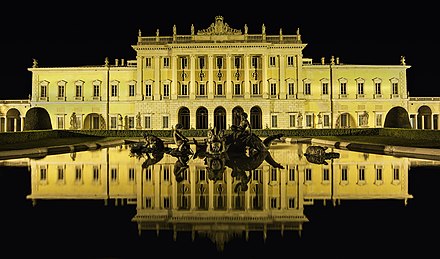
Leaving Villa del Grumello behind, and walking on along the path named Chilometro della Conoscenza (KM_C) you reach the fourth point of this itinerary: the Neoclassical Villa Olmo.
According to Giovanni Battista Giovio this is the dwelling described by Pliny the Younger, precursor of the myth of vacation on Lake Como. In a famous letter, still today translated by high school students, addressed to the poet Caninio Rufo Pliny the Younger writes:
«How is Como, the city of both my heart and yours? And what about that enchanting suburban estate? And that portico where it is always spring? And that plane-tree walk? And the canal with its purest waters?».
and addresses to his friend the recommendation:
«Design and give shape to something that is forever yours, because chance will grant all your possessions to someone else when you are gone».
An advice that was not followed by Rufo, as none of his works have reached us, except for citations, such as the one by Pliny who credits Rufo with a poem dedicated to Trajan on the conquest of Dacia. Citation which earned Rufo a bust on the façade of the classical studied high school Liceo Volta of Como.
During restoration works performed on the Villa in 2015, a Roman wall was found in the gardens. The discovery was interpreted as a proof of the intuition of Giovanni Giovio.
It is worth to take a walk around the gardens before leaving the Villa Olmo. The gardens, reopened in 2018 following renovation works, include numerous veteran trees amongst which: a majestic cedar of lebanon (Cedrus libani), an horse-chestnut tree (Aesculus hippocastanum), some examples of secular American sycamore (Platanus occidentalis), a giant sequoia (Sequoiadendron giganteum), and a red beech (Fagus sylvatica).
The gardens are open from beginning of April to end of September, every day from 07:00 to 23:00, and from beginning of October to end of March, every day from 07:00 to 19:00. The Villa is open to the public Tuesday to Sunday, from 10:00 to 18:00. Access to the gardens is free (when organising your visit it is recommended to check opening hours on the Villa's website ).
Completed the visit, leave the gardens from the gate opposite to the one used on entrance. Right in front of the gate starts the pedestrian path of the Villas of Borgo Vico (today named passeggiata Lino Gelpi) that runs along the lake to reach the center of Como.
Distance between the fourth and fifth stage: 500 m, on foot approx. 5 min of flat standard road.
Note: The Ponte del Chilometro, the bridge which passes over Strada per Cernobbio connecting Villa del Grumello (stage 3) and Villa Olmo (stage 4), is open only on Sundays, from the last Sunday of March until beginning of November, and on holidays, from 10:00 to 19:00. In August the bridge is open all days. In case you take the itinerary on a closure day, it is possible to reach Villa Olmo walking along Strada per Cernobbio that runs along the lake in the direction of Como. After approx. 300 m the road starts going uphill (for cars), while it remains pedestrian along the lake and brings to Villa Olmo.
5 - Villa Gallia, Paolo Giovio
 Leaving behind Villa Olmo, after approximately 1 km walking along a path with the lake shore on one side, and historical Villas on the other side, the fifth stage is reached: Villa Gallia. Dating back to the beginning of the XVII century, it is the oldest building amongst all on this promenade.
Paolo Giovio (1483-1552), cardinal, but also physician and humanist here built his Villa in 1539, on those which he believes were the ruins of an ancient mansion belonging to Plini the Younger.
Leaving behind Villa Olmo, after approximately 1 km walking along a path with the lake shore on one side, and historical Villas on the other side, the fifth stage is reached: Villa Gallia. Dating back to the beginning of the XVII century, it is the oldest building amongst all on this promenade.
Paolo Giovio (1483-1552), cardinal, but also physician and humanist here built his Villa in 1539, on those which he believes were the ruins of an ancient mansion belonging to Plini the Younger.
Within his villa he created the first museum in the world: the mansion hosted a collection of portrait of illustrious men, a copy of which is displayed at the Uffizi Museum in Florence. Amongst the many pieces, there is the oldest and most common portrait of Christopher Columbus, today on display at the Civic Art Gallery of Como.
The poet and cardinal Pietro Bembo, paid homage to his contemporary, the precursor of the modern museum, in the sonnet:
«Giovio, you who collect the times and the works that are worthy of light in our century such graceful and fleeting ink that clear and dear you forever shall live ...».
The original building, a bold construction jutting out onto the lake, was soon ruined due to the lake's flooding, and was demolished in 1619 by Marco Gallio to make space for the current Villa. Today it is still possible to view the old mansion in three paintings on display at the Civic Art Gallery and at the Archaeological Museum of Como.
The Villa has remained the property of the Gallio family until 1772. Today it belongs to the Province of Como and the building and the gardens are not open to the public.
Leaving Villa Gallia behind the itinerary continues along the promenade of the Villas towards Como.
Distance between the fifth and sixth stage: less than 1 km, on foot approx. 10 min of flat pedestrian city road.
6 - War Memorial, Filippo Tommaso Marinetti
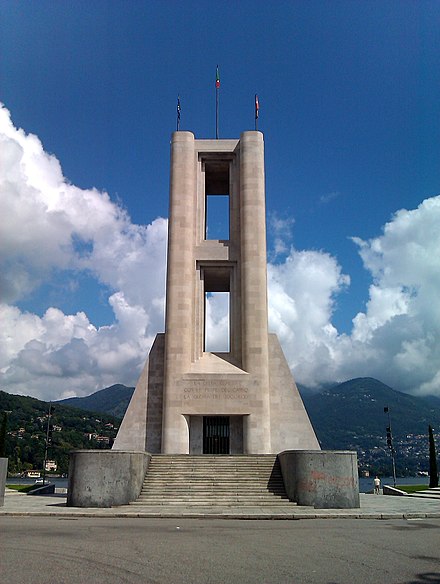
At the end of the promenade of the Villas/promenade Lino Gelpi, one finds the Como aero club. Following the road that skirts the lake along viale Giovanni Puecher one then reaches the War Memorial (in Italian Monumento ai Caduti). An iconic 30 m tall stone building that looks over the lake: an unmistakable symbol of Como's Skyline. This monument would not exist - in such shape - if it wasn't for the poet and author of the Manifesto of Futurism (1909), Filippo Tommaso Marinetti.
Marinetti came to Como in 1930 to celebrate Antonio Sant'Elia, architect and father of the Manifesto de L'architettura futurista (1914). During his visit, Marinetti promoted a coloured pencil and acquarel drawing of San'Elia representing a tower-lighthouse as inspiration for this monument. The project was then developed and completed by Giuseppe Terragni the master of Italian Rationalism architecture.
The monument was opened on November 4, 1933, after three years of construction works. Inside the Monument there is a monolith weighting 40 tons, coming from the Carso, on which are engraved the names of 650 natives of Como who fell during the first world war. Amongst the engraved names are also the ones of Sant'Elia, who died at the front in 1916, and of Terragni, who died in 1943 while returning from the Russian campaign.
The founder of Futurism (who died in Bellagio in 1944), the architect of the New City and the Lario are all celebrated in a the Poem in Mourning of F.T. Marinetti by the futurist aereopoet Ubaldo Serbo:
«death flees it replies sardonically in the water in the water in the water Sant’Elia reflected dreams...».
The War Memorial is open to the public every Sunday from April to October. In the months of April, May, June, September and October from 15:00 to 18:00. In July and August from 16:00 to 19:00. A maximum of 15 people per turn are allowed (when organising your visit, it is recommended to check updated opening hours on their website (dead link: January 2023)). Entrance €4 (full fee), kids under 6 free.
Distance between the sixth and seventh stage: 150 m, on foot few min along the lake promenade.
7 - Tempio Voltiano, Alessandro Volta
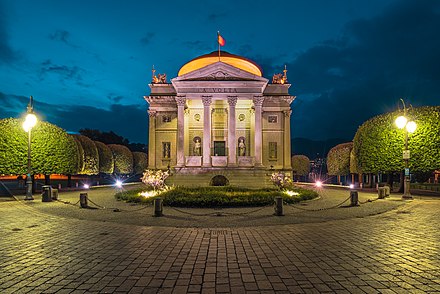
The next destination is a few meters away, but due to its prominence, can be seen by the naked eye from the War Memorial.
«The voltaic pile is the foundation of every modern invention»
asserted Albert Einstein in 1933 in the occasion of its visit at the Tempio Voltiano, a scientific museum dedicated to the physicist and citizen of Como Alessandro Volta .
The Palladian-style monument was designed by the architect Federico Frigerio upon commission by the local entrepreneur Francesco Somaini for the celebrations of the centenary of Volta's death in 1927.
The mausoleum hosts a collection of scientific instruments that belonged to Volta, whom not only invented the electric battery in 1799 (from which the unit of measure of the Volt), but also discovered methane in 1776, which he used in the Volta's lamp and in the electroflogopneumatic pistol, the precursors of modern gas lamps and lighters.
Volta was not only a scientist but also a poet, in a juvenile text Volta describes the space were today rises the monument to him dedicated and were at his times young men used to flirt with their sweethearts:
«They hang around this girl and that girl in particular in a certain district which Prato d’Orchi (Ogre field) we nowadays call».
The ogres were the mosquitoes attracted by the mouth of the river Cosia that flows into the lake that today runs underground but back then was broad and uncovered.
The Tempio Voltiano is open from Tuesday to Sunday, from 10:00 to 18:00 (last entrance at 17:30). Entrance €4 (full fee), €2 (reduced fee), kids under 6 free. When organising your visit it is recommended to check the site's website for updated on opening hours, extraordinary openings and prices.
From the Tempio Voltiano take the wide pedestrian avenue that opens right in front (viale Guglielmo Marconi) up to a crosswalk. Here take viale Felice Cavallotti straight on until the first crossroad. Taking the road on the right via Sant'Elia leads to the seventh Little Free Library, which is inside the garden of roses. To continue the itinerary take instead the road on the left via Rubini that leads to piazza Volta. Cross the piazza in order to take the road exactly on the opposite side, underneath the arcades (via Domenico Fontana).
Distance between the seventh and eight stage: 700 m, on foot approx. 7 min along the lake promenade and on flat pedestrian city road.
8 - Piazza Cavour, Hermann Hesse
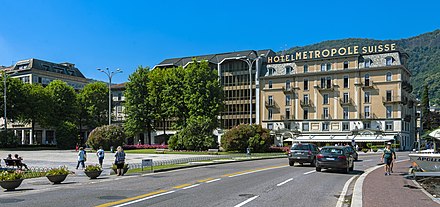
Walking along via Domenico Fontana leads to the eight's stage: Piazza Cavour, and to the discovery of Hermann Hesse, Nobel Prize for Literature in 1946, and of his 1913 Walk Around Lake Como, described in the collection of poems, essays and stories Wandering Italy:
«Differently from Lugano and all the other lakeside towns, Como turns its back on the lake, and even in the pretty piazza beside the port, you do not have the tedious and disquieting sensation of sitting in the first row of a deliberately created landscape».
Further in the text Hesse criticise the mountain where this itinerary ends: the liberty style villas that characterise the municipality of Brunate seemed to him squalid and pretentious. But maybe, if he had walked on food the distance between Como and Brunate, along the mule road in the woods as in the next stages of this itinerary, he would have changed his mind!
Back to his book, the following day to his arrival in Como, during a boat trip, Hesse doest resist to the charm of the
«craggy romanticism of steep villages»
and once reached the pier in Torno, on the western shore of the lake, he doesn't even get of the steamer, describing the scene as:
«It was such a perfect picture, so enchanting that I didn’t want to break its harmony».
Hesse then completed his trip in Moltrasio, on the opposite shore of the lake.
Distance between the eight and ninth stage: 250 m, on foot 3 minutes of flat pedestrian city road.
9 - Duomo of Como (portal), Plinii
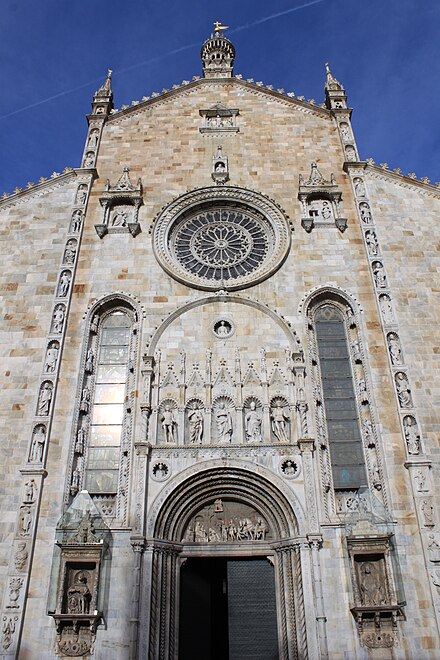
The Duomo di Como, that stands on the left side, is Lombardy's third largest religious building after the Cathedral of Milan and the Certosa of Pavia. Construction works began in 1396 and ended in 1744. The facade is dominated by the statues of the two Plinis, both born in Roman time Como. It is something unique to find two pagan figures in such a central position on a religious building. At the time of the Counter Reformation, the bishop of Vercelli Giovanni Francesco Bonomi, during his apostolic visit in Como proposed the removal of the two statues, works of the masters Tommaso and Giacomo Rodari, and dated 1480, but he had to desist in front of the strong opposition of the population.
Pliny the Elder is the author of the work which is commonly considered the first encyclopedia, the Naturalis Historia, while Pliny the Younger is the writer of one of history’s most famous collection of classical letters.
Distance between the ninth and tenth stage: 50 m, on foot few min of flat pedestrian city road.
10 - Duomo of Como (south facade), Caecilius

Amongst the many statues that decorate this facade, stands out that of a male figure with an open book in his hands: Caecilius, latin poet of the I century b.C. This is the third pagan figure represented on the Cathedral of Como.
No writings have reached us of this author. Caecilius is only known through the writing of Catullo, who dedicates to him a poem (Poem 35) were he narrates that Caecilius had been held in Como by a young lady, that had fallen in love with him after reading his pome dedicated to Cybele:
«I would like you, papyrus, / to tell Caecilius, the love poet, my friend / to come to Verona, leaving / the walls of New Comum and the Larian shore / for I wish him to receive / certain thoughts of a friend of his and mine. I forgive you, girl more learned than Sappho’s / muse: for the Great Mother of Caecilius / is elegantly underway».
Distance between the tenth and eleventh stage: 100 m, on foot few min of flat pedestrian city road.
11 - Town Theatre, Mary Shelley

Walking on along the Cathedral leads to piazza Verdi, a square dominated on the right by the grand Teatro Sociale (Town Theatre). The theatre was built between 1813 and 1821 and had the honour to host a season of the theatre La Scala of Milano, when this was damaged by the bombings of the second world war.
The theatre is also mentioned in the anecdotes of Mary Shelley, in her 1844 book Rambles in Germany and Italy. On August 15, 1844 Mary Shelly comes to the theatre to see the Lucia di Lammermoor, an opera by Donizetti. In such occasion she admires the curtain (velario) picturing Pliny the Elder, painted by Alessandro Sanquirico in 1812.
The frequentation of Como and its surroundings offered to the writer the cultural background for the most famous of her works: Frankestein or The Modern Prometheus . The references to Volta and the Plinii are found starting from the first chapter when Doctor Frankenstein is amused by the studies on electricity that he abandons the readings of the historical naturalists from the past, with the exception of Pliny and Bufforn, defined as «useful as well as interesting». Furthermore, in the second edition of the book, Mary Shelly, changes the story of the scientist half-sister/wife, Elizabeth, making her the daughter of an Italian patriot, imprisoned by the Austrians and adopted by the Frankensteins while on a trip to Como.
Arrived at this stage of the itinerary, one can choose amongst two alternatives. The main itinerary heads towards the twelve stage, walking a couple of km along the east lakeside promenade and then heads back to the Teatro Sociale, continues to the thirteenth stage and then towards the mule track that leads to Brunate (the fourteenth stage).
A first alternative is to postpone the twelve stage to the end, and thus continue with the thirteenth stage and the rest of the itinerary until the end, and then visit the twelve stage after taking the funicular from Brunate back to Como.
A second alternatives, recommended for those who do not want to walk the mule track uphill, is to go to the thirteenth stage, then come back to the eleventh stage, and then from here take the east lakeside promenade to reach the twelve stage. Halfway between the eleventh and twelve stage there is the Como - Brunate funicular, that can be taken to reach the fourteenth stage on the way back from the twelve stage. More details are supplied in the section dedicated to deviations.
Distance between the eleventh and twelfth stage: approx. 2 km, on foot approx. 20 min of city sidewalks along the lakeside. Distance between the eleventh and thirteenth stage: approx. 600 m, on foot approx. 5 min of flat pedestrian city road.
12 - Piazzetta Baratelli, August Strindberg
 From the Teatro Sociale, cross piazza Verdi, then take via Rodari which opens on piazza Roma. On the opposite side of the square take the pedestrian path between the Albergo Terminus and Palace Hotel, which leads to the lake. Cross the road on Lungolario Trieste and then walk on keeping the lake on the left side. After the touristic harbour the roads opens on piazza De Gasperi where the station for the funicular that leads to Brunate stands. Walking on, always along the lakeside promenade, the road arrives at the lookout of Punta Geno. Here rises Villa Geno, where the city lazaret of San Clemente was once located, as remembered by the Swedish writer August Strindberg] in his book From Italy. In the book the writer reports this anecdote of his boat trip from Como to Blevio:
From the Teatro Sociale, cross piazza Verdi, then take via Rodari which opens on piazza Roma. On the opposite side of the square take the pedestrian path between the Albergo Terminus and Palace Hotel, which leads to the lake. Cross the road on Lungolario Trieste and then walk on keeping the lake on the left side. After the touristic harbour the roads opens on piazza De Gasperi where the station for the funicular that leads to Brunate stands. Walking on, always along the lakeside promenade, the road arrives at the lookout of Punta Geno. Here rises Villa Geno, where the city lazaret of San Clemente was once located, as remembered by the Swedish writer August Strindberg] in his book From Italy. In the book the writer reports this anecdote of his boat trip from Como to Blevio:
«We pass under budding weeping willows, near an English villa. There is a small pavilion on a spit of land. Through an iron-barred window, a host of curious faces look out, but I’m surprised to see that they all have a white head». «Of course, they’re skulls, souvenirs of the «great plague»,
the boatman tells him.
Strindberg then returned to Como on foot along the ancient Strada Regia which:
«below chestnut and walnut trees, climbed up beside a rock face and, passing silk mills, got into town».
Walking further on a few meters, one arrives in piazzetta Baratelli where there is another Little Free Library.
Distance between the twelfth and thirteenth stage: approx. 2.5 km, on foot approx. 25 min of city sidewalks along the lakeside and of flat pedestrian city road.
13 - Museo civico, Giacomo Leopardi
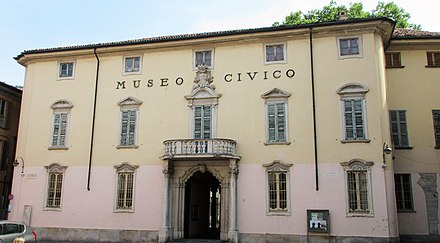
Amongst the many objects on display in the museum, there is a juvenile manuscript by Giacomo Leopardi dated 1816 that goes by the title of Death’s approach (Appressamento della morte). The manuscript was found in 1862 by Zanino Volta, nephew of the scientist Alessandro, in an abandoned area of the family mansion at 62, Via Volta, in Como.
It is thought that the manuscript had been given for reading to Pietro Giordani, and then passed on to Volta. Leopardi came to Como in 1825 trying to recover the manuscript but without success.
The Museum is open from Tuesday to Sunday from 10:00 to 18:00 (last entrance 17:30). Entrance €4 (full fee), €2 (reduced fee), kids under 6 free. When organising your visit it is recommended to check the museum's website for updated on opening hours, extraordinary openings and prices.
Distance between the thirteenth and fourteenth stage: approx. 2.5 km, on foot approx. 60 min first of city sidewalks slightly uphill and then uphill along the mule road (difference in level 450 m).
14 - Mule Road Como-Brunate, Alda Merini

From the Museo Civico the itinerary continues along via Balestra that leads out of the perimeter of the medieval walls of the city at the height of the San Vitale Tower. Crossed the rail crossing take via Grossi until it turns and changes its name to via per Brunate. Here on the left there is a stairway: the beginning point of the 'Como-Brunate mule track. On the way is another Little Free Library.
The mule track climbs along the mountain in a series of turns leading to the Hermitage of San Donato (Eremo di San Donato). Before reaching the Eremo there are two crossroads, at the first the itinerary keeps on the left, at the second on the right, always walking uphill.
The Eremo was built in the 15th century on the place were a sighting tower was located, which then became the bell tower of the church. In 1772, the place lost its original function of convent. Few years later it was sold and transformed into a private house, which still is today.
From the Eremo the mule road continues first encountering the main road and then arriving in the town of Brunate. A few meters after the road becomes asphalted stands the Chapel of the sacred family (Cappelletta della Sacra Famiglia).
The mule road built in 1817 is since 2019 dedicated to the poet Alda Merini. The Poet is closely linked to the territory as her father was from Brunate, and was the son of a count disinherited after deciding to marry a peasant. To commemorate the poet, a literary prize was instituted in 2011 in the so-called Balcony on the Alps (the other name with which the town of Brunate is known).
Distance between the fourteenth and fifteenth stage: 300 m, on foot approx. 5 min of standard city road.
15 - Public Gardens Alessandro Volta, Penčo Slavejkov
 The mule road ends in the town of Brunate. The asphalt road which has taken the place of the mountain road terminates in via Volta. Crossed the road on the right there is the pedestrian path that leads to the town hall and from there to via Monti. Crossed via Monti the path continues for 20 meters until a crossroad, here take the left and after a few steps one finds himself in piazza Bonacossa, where there is also the top station of the funicular.
The mule road ends in the town of Brunate. The asphalt road which has taken the place of the mountain road terminates in via Volta. Crossed the road on the right there is the pedestrian path that leads to the town hall and from there to via Monti. Crossed via Monti the path continues for 20 meters until a crossroad, here take the left and after a few steps one finds himself in piazza Bonacossa, where there is also the top station of the funicular.
Arriving on the square on the right one can easily notice the fountain, and next to the fountain a small staircase leading to the Public Gardens Alessandro Volta. Inside the gardens is a bronze bust of the Bulgarian poet Penčo Slavejkov. The bust was positioned here in 2007 by the Bulgarian government on the occasion of the 95° anniversary from the death of the poet who had chosen Brunate as the place where to spend the last years of his life. Here Slavejkov lodged at the Hotel Bellavista, a building of a bright yellow colour which can be seen from the gardens. In remembrance of the distinguished guest a plaque has been positioned on the hotel's outside wall, with the following lines:
«Let God grant that I should end my days here Alone and away from my native soil».
Distance between the fifteenth and sixteenth stage: 1.5 km, on foot approx. 25 min uphill along city road and then along another mule road (difference in level 150 m).
16 - Faro Voltiano
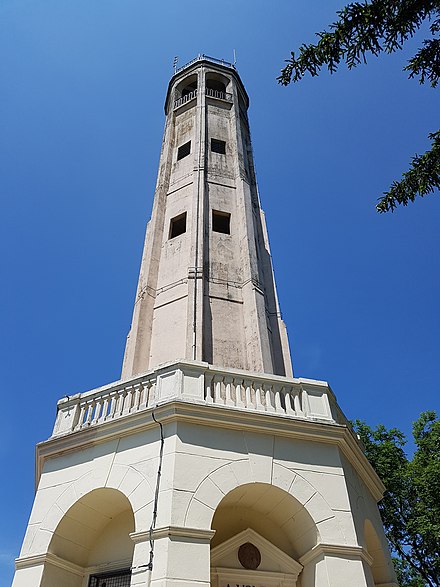 To end the itinerary, leave the gardens from the exit left of the public library. The pedestrian passage brings to the square of the church which has to be crossed to reach via Beata Maddalena Albrici. After a few meters turn right and keep on via Beata Maddalena Albrici: here the uphill road starts. At the end of the street continue on the left on via Scalini. After the crossroad with via Varesello on the right of via Scalini starts the mule road to San Maurizio. The mule road goes uphill crossing many times the main motorable road, and meets with the same on the square in front of the San Maurizio church.
To end the itinerary, leave the gardens from the exit left of the public library. The pedestrian passage brings to the square of the church which has to be crossed to reach via Beata Maddalena Albrici. After a few meters turn right and keep on via Beata Maddalena Albrici: here the uphill road starts. At the end of the street continue on the left on via Scalini. After the crossroad with via Varesello on the right of via Scalini starts the mule road to San Maurizio. The mule road goes uphill crossing many times the main motorable road, and meets with the same on the square in front of the San Maurizio church.
In the green area in the center of the square there is the last of the Little Free Library of this itinerary. Right in front of the church there is the last part of via Scalini, that leads to the Faro Voltiano. Inside the lighthouse, 143 steps of a spiral staircase lead to the balcony of the lantern from which to admire a large portion of the Alpine arc, as well as an overview of the itinerary from Cernobbio to here.
For opening hours of the Faro Voltiano see the operator's web page (dead link: December 2020). Entrance €2 (full fee), €1 (reduced fee up to 18 years).
Deviations
Cernobbio: The Lakeshore and the Giardino della Valle
Arrived at the second stage, Villa Besana Ciani, before heading towards the third stage it is worth to take a short visit to Cernobbio, reaching two Little Free Libraries.
From Villa Besana Ciani, walk on along the street until reaching the crossroad with via Garibaldi. On the right opens up piazza Risorgimento, characterised by the marble fountain and from where you can see a panoramicc view over all the first basin of the lake. Today Cernobbio Lakeshore is a large and green promenade, with trees, benches, bars/restaurants, at the end of which is the Liberty-style pier (built in 1906) from which to take one of the boats to discover the lake. Along the shore there are also the monuments dedicated to Garibaldi and to the war dead. In piazza Risorgimento is one of the Free Little Libraries of Cernobbio.
Going back to via Garibaldi and walking until the end one reaches via Vecchia Regina. Turning right and walking for 400 meters one finds on the left via Adda. This dead end road leads to the Giardino della Valle (web site), a botanical garden build out of an illegal dump. Inside the garden there is another Free Little Library.
From Como to Brunate with the funicular
Brunate can be reached also with the funicular. The base station of the funicular is in piazza De Gasperi on the lake promenade approximately half way between the eleventh and twelve stages. Timetable and prices of the funicular are available on the website: the ride lasts approx. 10 min, during high season take into account the possibility of having to queue at the station to wait for the second or third ride.
In Brunate, the funicular arrival station opens on piazza Alberto Bonacossa. From here walking towards the artificial waterfall that closes the square north it is easy to identify the stairs that lead to the gardens where there is the bust of Pencho Slavejkov, fifteenth stage of this itinerary.
Stay safe
No specific risks on this itinerary. Como and the surroundings are generally quite safe places. Since part of the itinerary is uphill and along old mule roads, as indicated at the beginning, it is recommended to wear good and comfortable shoes, and if approaching the itinerary on a spring or summer day remember to bring water with you.
Go next
Como is a good starting place to explore Lake Como: it is easily reached from Milano, and from Malpensa Airport, as well as from Switzerland and northern Europe. From here one can go walking/hiking on the surrounding mountains (many one day trips possible) or simply enjoy the lake, its Villas and towns.
Related: Europe